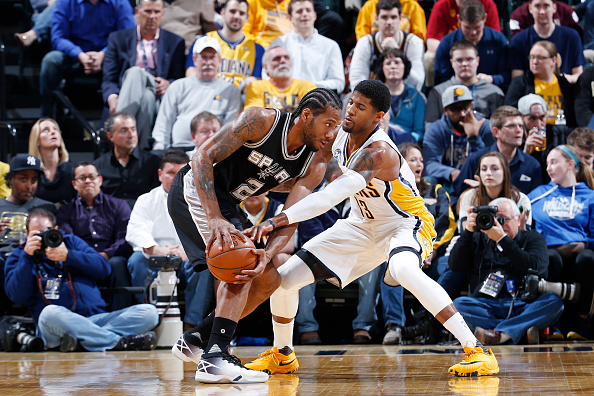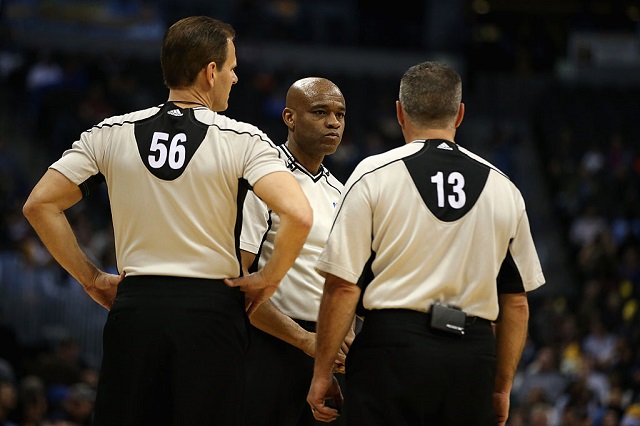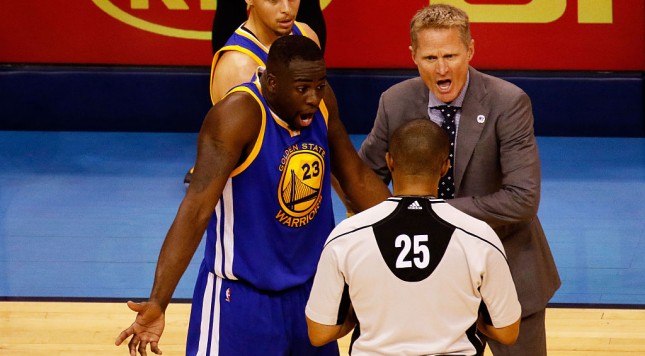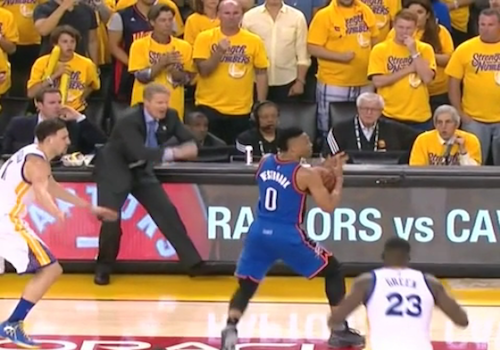A major postseason sporting event featured an important kick on a Sunday… and it had nothing to do with three points in an NFL playoff game.
This wasn’t a missed 27-yard kick by Blair Walsh. This was a made one-yard kick by Draymond Green of the Golden State Warriors. He committed what the NBA called a dead-ball foul (you can’t make this stuff up) against Steven Adams of the Oklahoma City Thunder in Game 3 of the Western Conference Finals:
Monday… https://t.co/9ObdMvnyO2 https://t.co/VRdGPSiqlM
— SB Nation (@SBNation) May 23, 2016
The moment was all anyone could talk about after Game 3 ended. It remained a news story on Monday when the NBA chose not to suspend Green — tagged with a flagrant foul — for Game 4:
Draymond Green not suspended for Thunder-Warriors Game 4 https://t.co/0ftV2yzjHP pic.twitter.com/ojk0zmu1Wp
— The Comeback (@thecomeback) May 23, 2016
You might think this is typical Draymond Green bullspit, the kind of behavior he continuously engages in and doesn’t get punished (enough) for. You might think this is completely unintentional and therefore not a big deal. You might step into the middle and say that Draymond’s intent has nothing to do with whether a foul warrants an ejection or suspension.
For any of these subgroups, or interested observers who don’t fit neatly into any category, let it be known: Draymond Green’s kick is bigger than any category. It’s bigger than the NBA, bigger than officiating itself. The possibility of Draymond getting suspended for Game 4 is an interesting in-the-moment drama, good for a 24- or 48-hour news cycle at most.
The true significance of this kick dwarfs a 48-hour news whirlwind to an extent you can’t readily imagine.
Draymond Green’s kick has shown us the future of all team sports — or at least, what they can become in a more enlightened society.
“Whoa there, slow your roll — let’s not try to blow this out of proportion or anything…”
That’s an understandable reaction.
All I can say is this: If you closely consider what’s said (and shown) below, some of you might begin to realize why Draymond’s “one-yard field goal” could transform sports as we know them… for the better.
You’ve seen Draymond’s kick in multiple images above. Let’s start our larger conversation with a different visual. It comes from Game 4 of the Cleveland Cavaliers-Toronto Raptors series on Monday night:
Interesting move, not necessarily a basketball move, but Lowry is doing whatever it takes to get FTs. https://t.co/oLQUCLwQz8
— BBALLBREAKDOWN (@bballbreakdown) May 24, 2016
You can plainly see that Kyle Lowry, in an attempt to sell a foul call, wildly and severely extends his legs and feet. It is not a normal basketball play in the sense that it doesn’t represent anything common to a straightforward shooting process or technique. There’s nothing in a textbook which recommends or encourages such a movement of the body.
However, this IS a normal basketball play in the sense that while it is uncommon in terms of technique, it is common to what we see in the NBA every gamenight. This wasn’t always the case, but it is in this day and age. When Steve Kerr (and my Crossover Chronicles colleague John Cannon) said that Russell Westbrook does what Lowry and Draymond did the past two nights, that’s not an incorrect statement.
One doesn’t even have to focus on Westbrook, or James Harden, or any other individual. You can see in the Draymond incident (because he happened to make solid contact) and the Lowry non-incident (because he whiffed) what regularly happens in the modern NBA: Players wildly flap their arms and throw out their legs as part of the exaggerated body action which is sometimes needed to sell foul calls.
This is why Draymond’s kick is such a problem for basketball, such a thoroughly difficult issue to resolve: It’s not a basketball play in terms of technique, but it IS a basketball play in terms of the evolving culture of the sport. You’re not supposed to see it every night, but you do see it every night. When that split between technique and culture exists, where’s the Solomonic middle ground which splits the difference? This is a vast and overwhelming gray area.
In response, the NBA (and other sports leagues which suffer from similar gaps) can’t merely make a minor tweak to its rulebook and its officiating points of emphasis. Broader, more far-reaching action is needed.
In order to understand this tension and why it matters, one must realize how we got here in the first place.

INDIANAPOLIS – MARCH 23: Reggie Miller #31 of the Indiana Pacers battles Bruce Bowen #12 of the San Antonio Spurs on March 23, 2005 at Conseco Fieldhouse in Indianapolis, Indiana . The Pacers defeated the Spurs 100-93. (Photo by Ron Hoskins/NBAE via Getty Images)
Remember Reggie Miller, recently profiled by Shlomo Sprung at Awful Announcing? He started all this. Reggie Miller — even more annoying today — was enough of an annoyance over 20 years ago… and not for his trash-talking or overall demeanor.
Reggie Miller became the man most responsible for altering the NBA’s rules on airborne shooters. His propensity to extend his legs (or his knees) on his shots fooled NBA refs for many years. Reggie would take the tumble because his limbs were splayed at odd angles, but he was often the player initiating the contact while the defender maintained verticality and a generally legal guarding position. Yet, refs would call the foul on the defender. Finally, in 2012, the rules were amended to punish airborne shooters extending their limbs.
Yet, all the head-snapping, leg-kicking and knee-thrusting we continue to see from Draymond Green, Kyle Lowry, Chris Paul and so many others (it’s not one or even two players) shows that contact initiated by shooters remains a problem, under-called and under-policed by the NBA. It’s instructive to note that Draymond’s kick in Game 3 wasn’t called a flagrant in real time. It was reviewed after the fact. This followed a Game 2 sequence in which Draymond brought a knee to Adams when making an offensive move with the ball… and wasn’t slapped with a flagrant.
Officials just can’t keep up with this kind of action. The natural question to ask: Does this mean officials stink (and/or are getting worse)? It’s easy to say yes, but I’m going to tell you: No, it doesn’t.
The key point, the heart of this whole piece, is as follows: Draymond’s kick must revise and simplify the NBA rulebook. More broadly, Draymond’s kick should serve as a call to all major professional sports leagues to revise and simplify their rulebooks, while also adjusting officiating points of emphasis to make life easier for referees.
This is the upshot of Draymond’s kick: It shows that we (as sports leagues and larger sports communities) have come to expect too much of officials. More precisely, we load far too many responsibilities on officials and expect them to get every (or almost every) call right.
You might recall that at the end of Game 1 of Thunder-Warriors, referee Monty McCutchen — regarded as one of the better NBA refs in the business — missed a traveling call on Russell Westbrook. You can see Steve Kerr plead for the call:
Warrior fans complained a lot, but as this video below shows, traveling is simply not called (to any meaningful extent) in the NBA. You have very likely known this for years, but this sequence affirms it:
https://twitter.com/Shaqtin_A_Fool/status/732418996348276736
Mike Goldfarb of Shaqtin A Fool has performed a profound public service by collecting several other uncalled (egregious) travels such as that one. The (ridiculous) uncalled travels in the NBA might make officials look bad, but if your instinct is to rip officials, stop and consider how much a basketball official is expected to process beyond traveling:
** 3-second lane violations, offensive and defensive
** Out-of-bounds violations
** Defensive fouls (while guarding a ball-handler)
** Offensive fouls (player control)
** Defensive fouls (off ball)
** Offensive fouls (off ball, usually moving screens)
** Loose-ball fouls
** Technical fouls
** Flagrant fouls
** Substitutions
** 8-second violations
** 24-second violations (involving the ability to discern if a shot beat the shot-clock buzzer)
** Goaltending
** Basket interference

DENVER, CO – APRIL 5: at Pepsi Center on April 5, 2016 in Denver, Colorado. The Thunder defeated the Nuggets 124-102. (Photo by Doug Pensinger/Getty Images)
That’s not even a complete list. These are merely the most common calls (aspects of game play) officials must process in a confined space.
Why is this important, and how does this relate to the Draymond kick and all of sports? Good question.
Here’s what you need to appreciate about the larger task of officiating, in any sport: If your eyes are focused on a “boundary” play relating to spatial movement — Is a guy out of bounds? Did he drag his pivot? Is he in the paint or not? Was the ball in the cylinder when tipped? — your eyes cannot realistically focus on the plays relating to physicality and violence.
Yes, the lead and trail officials (lead = under the basket or on the baseline; trail = near halfcourt) divide responsibilities. Yes, basketball officials spend pregame preparations discussing their coverages and the tricky process of ceding one area of the court to the other. There’s an established method for sharing the workload in order to ensure that violent acts (fouls, illegal screens, dirty plays) and spatial violations (traveling, basket interference, 3 seconds in the lane) both get called by a three-man crew.
Yet, even with a three-man crew, a kick to the groin needed to be reviewed Sunday night in Oklahoma City. The problem is not that the play was reviewed, but that it wasn’t policed in the present moment. That in itself shows how naturally difficult it is for officials to keep up with everything (physical) which happens in an NBA game… not counting the exaggerated salesmanship players use because they’re not confident refs will call normal contact on shots and drives to the basket.
The point is simple but profound: If referees didn’t have to worry about 3-second violations or basket interference, and several other calls which didn’t require them to have a clock in their heads or make a count by moving their right arm, their minds would be so much clearer. With a reduced workload — several kinds of calls would no longer be on their plates — they could spend that much more time officiating the things which require supreme vigilance. They could promote player safety and become exponentially more effective in weeding unnecessary and excessive contact from basketball.
https://youtu.be/hyKYiC7lHvY
They’d call more fouls at the initial stages of contact, the hand-checks and rakes and moderate grabs on the perimeter or 10 feet from the basket. This would have a domino effect, in that if refs called more of those kinds of fouls, players wouldn’t have to sell as many foul calls… which would mean fewer instances of the exaggerated bodily actions engaged in by players such as Draymond Green and Kyle Lowry. Remember, Lowry hit no one, so we’re not talking about his crazy-angle kick in Game 4. It’s only because Draymond was close to his defender — and then made direct contact in a sensitive spot — that his mistake went viral. Had Lowry hit LeBron in the male organs, just as much of a furor would have emerged.
Are we done here? With the NBA, yes… as long as we realize that if we eliminate 3-second calls, basket interference, and like violations to free up officials to focus more on violence and foul calling, the quality of officiating (and the game) will skyrocket.
There’s just one more simple thing to say beyond professional basketball.

OAKLAND, CA – DECEMBER 20: Referee Walt Anderson #66 looks on after talking with the umpires in the first quarter of the game between the Green Bay Packers and the Oakland Raiders at O.co Coliseum on December 20, 2015 in Oakland, California. (Photo by Lachlan Cunningham/Getty Images)
NFL officials aren’t bad or stupid; they are merely given a ridiculously bloated, complicated, and poorly-written rulebook to enforce. If the NFL rulebook involved fewer rules, simpler rules, and lower thresholds for satisfying certain football actions — a legal catch being the obvious No. 1 item on the list (maybe the top 10 items by itself) — we would think differently of officials. We would commend them a lot more. We wouldn’t question them as much because they wouldn’t have to enforce nearly as many rules, nearly as much complexity within the rule structure, or nearly as many high thresholds for certain kinds of football actions.
What exists in the NFL exists in soccer and the NHL in terms of offside rules. If refs in soccer and hockey didn’t have to worry about purely spatial questions — is a man behind, on or over a certain in-bounds line on the playing surface? — their eyes AND their minds would be liberated, able to focus on calling fouls or penalties better. Player safety would be promoted. Ticky-tack violations (which seem to inhibit the free flow of players and reduce the extent to which crowd-pleasing offense flourishes, both bad for the commercial product) would cease to exist.
THIS is what Draymond Green’s kick can mean, everyone. It’s not an inherent meaning, but a set of potential meanings — how the kick can reform the NBA, how it can reform all our sports, how it can transform the rulebooks in our sports, how it can improve the officiating points of emphasis each league brings to its rulebooks.
If every major sports league learned the right lessons from Draymond Green’s kick, the larger product of professional sports — in the year 2020 — could be a million times better than it is today, far greater than we can currently imagine.
Hyperbole? Only if you think the substance of this larger argument is not what you want to see in sports 10, 20, or 40 years from now.


